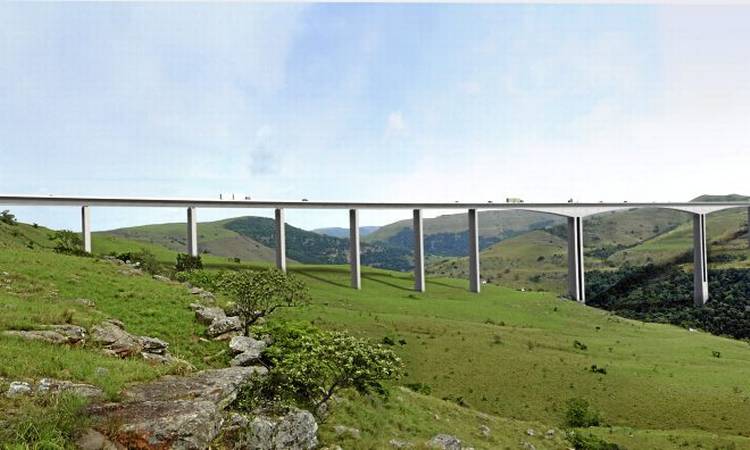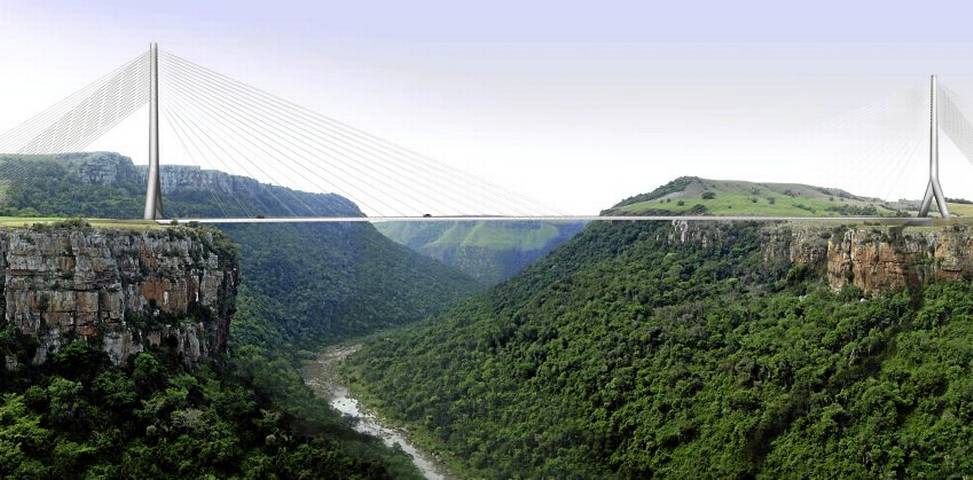
An essential part of Sanral’s N2 Wild Coast Toll Road project is the construction of two record-breaking mega-bridges over local rivers. One will become the highest bridge in the southern hemisphere, and the other possibly the longest cable-stayed suspension bridge in Africa.
Two spectacular mega-bridges are about to be added to South Africa’s growing national road network.
These are part of the South African National Roads Agency SOC Limited’s (Sanral) N2 Wild Coast Toll Road (N2WCTR) project. They will offer visual and engineering delights to citizens and tourists alike.
The first mega-bridge will cross the Mtentu River just outside of Xolobeni. The second will cross the Msikaba River near Lusikisiki.
The Mtentu Bridge will be one of the longest main-span balanced cantilever bridges in the world, and the first of its size in South Africa.
Reaching heights of around 220 metres, it will become the highest bridge in Africa and the whole of the southern hemisphere. The current highest is the Bloukrans Bridge, which has a 217-metre deck height.
The construction of the 1.1-kilometre-long bridge in a remote location is a major undertaking requiring specialised engineering skills and building techniques, according to Edwin Kruger, Sanral’s Bridge Network Manager.
“No South African firm has ever done a balanced cantilever bridge of this magnitude before,” says Kruger. “As such, South African tenderers have joint ventured with international firms to bring skills and expertise into the bridge’s construction.”
The second mega-bridge, the Msikaba Bridge, will be 580 metres long.
“This bridge will cross the spectacular and pristine Msikaba river gorge and will be the longest span cable-stayed suspension bridge in South Africa – and possibly Africa,” says Kruger.
“Cable-stayed bridges are distinct in their use of towers and cables to support the bridge deck. This single span bridge will be anchored back into rock on either side of the gorge.”

Infrastructure for economic development
The bridges form the backbone of greenfields portion of the N2WCTR. The Wild Coast project is a national priority coordinated and directed by the Presidential Infrastructure Coordinating Commission.
It is one of the government’s 18 Strategic Integrated Projects to support economic development and boost service delivery in South Africa’s poorest provinces, such as the Eastern Cape.
“The bridges form part of the greenfields section of the Wild Coast Highway project,” says Kruger. “Extending from Port Edward through Port St Johns, this section is a brand new road and without the bridges we cannot complete the highway.”
Putting the environment first
One of the environmental requirements was that Sanral does not touch the unspoiled Msikaba gorge at all. The cable-stayed design will ensure that the construction of the bridge will have no direct impact on the environment in the gorge, almost 200 metres below.
Environmental lobby groups have expressed concern related to the N2WCTR’s impact on the Pondoland Biome. But Sanral has used specialist studies conducted during the environmental impact assessment to ensure that the route avoids the most sensitive areas of the Pondoland.
More than this, rehabilitation measures include a search and rescue programme for threatened or protected flora species. A biodiversity offset agreement has also been established with the Eastern Cape Parks and Tourism Board. This will ensure that the Pondoland Biome is preserved for generations to come through the declaration, rehabilitation and ongoing protection of some 15 000 hectares of new conservation areas.
Conservation measures are put in place before any work begins on the highway, according to Craig McLachlan, Sanral Southern Region’s Project Manager. “Before we start any construction we will send a specialised team into the area to retrieve bulbs, succulents, and other plants that can be relocated,” he says.
“We have set up nurseries that then preserve and further propagate these plants. These plants are then used for rehabilitation, and when we have an excess they will be translocated into protected areas such as the Mkambati Nature Reserve.”
Access for tourists and communities
According to Kruger, pedestrian sidewalks will be constructed on each side of the bridges and view sites off the bridges will provide special viewing points for tourists. The sidewalks will also serve to connect communities on either side of the gorges.
“The Msikaba and Mtentu bridges will become tourist attractions in their own right, and will offer opportunities for the associated tourism industry in the area,” says Kruger.
The Mtentu and Msikaba bridges and the overall greenfields portion of the N2WCTR will play a vital role in improving travel time, connecting previously divided communities in the region and opening up the Wild Coast’s opportunities for eco-tourism, adventure tourism and community-based tourism.
More than this, the road will connect the Wild Coast to the broader economy. As McLachlan says: “By improving the travel time between Durban and East London by up to three hours for heavy freight and by providing a high mobility route through an area that is currently extremely isolated and underserved by road infrastructure the route will have significant social and economic benefits and will act as a catalyst for local and regional development.”
A boost for the local economy
Kruger says the labour requirements of the project means jobs will be created in the local community. “Since both bridges have a large concrete component labour will be needed for fixing steel and placing the concrete for the bridges,” he says. “Semi-skilled and unskilled labour will be sourced locally.”
McLachlan adds that as part of Sanral’s small, medium and micro enterprise (SMME) development programme, local small businesses will be given the skills needed to join the project’s development. This will be in the form of full learnerships focussing on a both road construction and business skills.
“The SMME development programme will help to ensure that jobs created by the N2 greenfields project can be filled by local contractors,” he said.
SMME participation is an essential component of all Sanral projects. Over R1.5-billion will be spent on SMMEs during the construction phase the 110 kilometres of new roads and bridges.
This will in turn help create an estimated 50 000 direct and indirect jobs locally and regionally during and after construction. McLachlan explains that as wages earned typically have a multiplication effect in the local economy of two to three times, this job creation will further boost the local Wild Coast economy.

